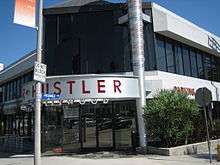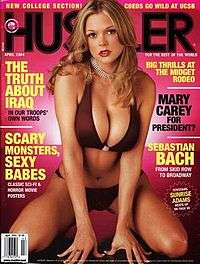Hustler
|
Sunrise Adams on the April 2004 cover of Hustler | |
| Publisher | Larry Flynt |
|---|---|
| Total circulation (2006) | approximately 500,000 |
| Year founded | 1974 |
| Company | Larry Flynt Publications |
| Country | United States |
| Language | English, many others |
| Website | Hustler Magazine |

Hustler is a monthly pornographic magazine published in the United States. It was first published in 1974 by Larry Flynt. It was a step forward from the Hustler Newsletter, which was cheap advertising for his strip club businesses at the time. The magazine grew from a shaky start to a peak circulation of around 3 million; it has since dropped to approximately 500,000. It shows explicit views of the female genitalia, becoming one of the first major US-based magazines to do so, in contrast with relatively modest publications like Playboy.[1]
Today, Hustler is still considered more explicit (and more self-consciously lowbrow) than such well-known competitors as Playboy and Penthouse. It frequently depicts hardcore themes, such as the use of sex toys, penetration and group sex.
Larry Flynt Publications also licenses Hustler brand to the Hustler Casino in Gardena, California which is owned directly by Larry Flynt as an individual through his holding company El Dorado Enterprises, the Hustler Club chain of bars and clubs, and Hustler store chain that sells adult-oriented videos, clothing, magazines and sex toys. The chain's flagship store is on Sunset Boulevard in West Hollywood.
Publisher

Hustler is officially published by LFP, Inc, which also produces pornographic films. The abbreviation "L.F.P." originally stood for "Larry Flynt Publications."
A Canadian version of Hustler is published by a Quebec-based firm. This magazine is not owned by Larry Flynt, but is licensed to publish material from the American version. In general, Canadian Hustler imitates the appearance and tone of its American counterpart, with Canadian content added. In 1999, the magazine created a minor controversy in Canada by inviting readers to submit sexually explicit stories about Sheila Copps, a left-leaning member of the Liberal cabinet. There have also been Australian, British and South African versions of the magazine.
During a bookstore signing in July 2011, Flynt stated that less than five percent of his income comes from the print magazine; he also speculated that the print magazine will not be around in 2 to 3 years.[2]
Regular features
One feature of Hustler is a column called "Asshole of the Month." In every monthly issue of the magazine, a selected public figure is selected for severe criticism as that month's asshole. An illustration depicting the criticized person's head emerging from the anus of a cartoon donkey is shown alongside the article. After Flynt’s imprisonment in 1977 and his alleged conversion to evangelical Christianity, he promised to reform “Asshole of the Month”. However, as of 2016, reform in the feature has yet to been seen.[3]
In the 1970s, Hustler ran a comic strip feature entitled "Honey Hooker". In each installment, Honey would have graphic sexual encounters with any male (or female) she ran across. She might be in American colonial times one month or in a Super Bowl locker room the next. This feature was designed to compete against Playboy's Little Annie Fanny and Penthouse's Wicked Wanda. In keeping with Hustler's focus on the seamier and less romantic aspects of sexuality, Honey Hooker, unlike Fanny and Wanda, was explicitly portrayed as being a prostitute.
The Beaver Hunt section of the magazine contains explicit nudes of amateur models submitted by readers.[4]
Another Hustler feature that was heavily criticized was the “Chester the Molester” cartoon. Each month’s issue depicted Chester, a cartoon middle-aged pedophile, joyfully raping girls. Following Flynt’s alleged religious conversion, he introduced “Chester the Protector”, a reincarnation of the molester character who served as a hero to protect young girls from rape and seduction.[3]
A regular feature entitled “Ads We’d Like to See” recreates advertisements of everyday products in a sexualized or violent way. For example, an advertisement in the 1980 issue called 'Doer’s Lite Label', a parody of Dewar's Lite Label Whiskey, featured Kenneth Bianchi, the Hillside Strangler. Listed as his greatest accomplishment was Cindy Lee Hudspeth, whom he actually strangled in 1978. He’s quoted as saying “You gotta treat ‘em rough…”. This section was highly criticized for admiring men who’d committed sexualized crimes against women. [5]
In addition to its regular features, Hustler also occasionally published special features and issues. Examples include the “All Meat” issue from 1978, where the cover spread depicted a naked woman being fed into a meat grinder upside down. In 1977, the magazine’s front page read “First-Time Ever Scratch ‘N’ Sniff Centerfold”.[3]
Controversy/Criticism
in 1984, conservative academic Judith Reisman received a grant from the Department of Justice to complete a study at American University concerning the cartoons of Playboy, Penthouse, and Hustler, specifically the sexual depictions of minors in these cartoons. She finished the study in 1986, and found that on average, the amount of times per issue that Hustler referenced children, crime, and violence was 46.[6]
Reisman published a nearly 1,600 page report of her findings, condemning the sexual depictions of children in pornographic magazines, but her work was met with criticism from her peers.[7] An American University professor, Dr. Myra Sadker, said that she was “very dismayed about the quality of office management and the nature of the research that was going on.”[8] Many fellow academics have disputed the neutrality of the research. Avedon Carol, a sex crime researcher and author, said that Reisman’s study was a “scientific disaster, riddled with researcher bias.”[9]
In 1989, Hustler's chief cartoon artist Dwaine Tinsley was arrested on May 18, 1989, after being accused by his 18-year-old daughter Allison of molesting her since she was thirteen years old. According to court records, he allegedly told his coworkers, "You can't write about this stuff all the time if you don't experience it."[10] Tinsley was found guilty of five counts of child molestation and sentenced to six years in prison[11] although he only spent 23 months behind bars. Tinsley was the artist behind the regular "Chester the Molester" series, which ran from 1976 to 1989.
In a 2012 issue of Hustler, S.E. Cupp, a conservative commentator, was photoshopped and depicted as explicitly performing oral sex. The article describes S.E. Cupp as a "lovely young lady who read too much Ayn Rand in high school and ended up joining the dark side...But her hotness is diminished when she espouses dumb ideas like defunding Planned Parenthood."[12] Despite having a disclaimer that the photo was not real, the photograph horrified Cupp, knowing that “this photo will be out there forever.”[13] Flynt’s response was that the photoshopped image was meant to be satirical, quoting that "I'm able to publish this because of the Supreme Court case I won in 1984, Flynt V. Falwell."[12] Cupp will not be pursuing either Flynt or the magazine because of "free speech." [13]
Lawsuits/Litigation
The magazine has had many lawsuits from the 1980's, including claims of defamation and enforcement of sexual violence and behavior. However, there have not been any lawsuits against the magazine or incorporation as of 2016.
In the Douglass v. Hustler Magazine Inc., actress Robyn Douglass sued Hustler for defamation and unlawfully placing her under a false light.[14] Douglass posed nude for freelance photographer Augustin Gregory, believing that her photos would appear on an issue of Playboy Magazine. However, Gregory was hired to Hustler and Douglass’ photos were published in the 1981 January issue without Douglass’ consent. She brought the case to the United States District Court from the North District of Illinois on the basis that the magazine had defamed her name and likeness.[14] The court cases ended in favoring Douglass since the magazine had violated her right of publicity, awarding her $600,000.[14]
In the 1984 Keeton v. Hustler Magazine, Inc. court case, Kathy Keeton, Vice Chairman of Penthouse, sued Hustler magazine for defamation.[15] Keeton brought the case to New Hampshire due its generous 6-year statute of limitations for libel and the State believed it was able to support taking jurisdiction due to the magazine’s content.[16][17] The magazine sold up to 15,000 issues since 1975, containing a cartoon where Keeton had received a venereal disease from Robert Guccione, a publisher of Penthouse.[18] Keeton was awarded $2 million for the defamation damages.[18]
In Herceg v. Hustler (1989), a family attempted to sue Hustler for the suicide of their fourteen year old boy on the basis that its illustrations stimulated violence.[19] Within the magazine’s contents was the article “Orgasm of Death”, demonstrating practices of erotic asphyxia via photographs in order to heighten sexual pleasure in men.[20] However, Hustler placed disclaimers on the photographs of “Do Not Attempt” to prevent the audience from mimicking the photos. The court case ended in favoring the magazine; the court agreeing that the depictions were not enforcing readers to perform these erotic or dangerous activities.[20]
Editorial policy
Hustler has had what would be considered a left-wing (liberal) editorial policy on economics, foreign policy, and social issues. Flynt and Hustler are also noted for having a more populist and working-class outlook than the more upscale-oriented Playboy and Penthouse. Throughout the 1980s, Flynt used his magazine as a podium with which to launch attacks on the Reagan Administration and the Religious Right, and even published a short-lived political magazine called Rebel. During the controversy surrounding Bill Clinton's impeachment, Flynt publicly announced his sympathy for Clinton, and offered cash rewards to anyone with information regarding sexual impropriety on the part of the president's critics. In 2003, Flynt ran unsuccessfully for the office of Governor of California during that state's recall election.
Every month Hustler is mailed, uninvited and for free, to all of the offices of Members of the United States Congress.[21] This practice began at some point between 1974 and 1983, and it continues as of April 2014.[22] In an interview, Flynt explained, "I felt that they should be informed with what's going on in the rest of the world ... Some of them didn't appreciate it much. I haven't had any plans to quit."
In a 1983 parody of an advertisement for Campari, Hustler described the then-prominent fundamentalist Protestant minister Jerry Falwell having a drunken, incestuous encounter with his mother in an outhouse. Falwell sued Flynt, alleging libel and intentional infliction of emotional distress. The case was ultimately decided by the Supreme Court in Flynt's favor. The decision strengthened free speech rights in relation to parodies of public figures. See Hustler Magazine v. Falwell
Other venture
Related magazines
LFP, Inc. publishes several other magazines that use the Hustler brand:
- Hustler's Taboo, specializing in fetishistic material, such as the depiction of sexual bondage and urolagnia
- Barely Legal, a primarily softcore magazine focusing on models between 18 and 23
- Asian Fever, focusing on Asian models
- Hustler XXX, a more generic hardcore offering
Websites
In 1995, the company launched Hustler.com.[23] Larry Flynt Productions, operates Hustler.com and a number of related sites, where it sells pictures and videos with content similar to that in its magazines. The site was targeted by Anonymous in Operation Payback in October 2010.[24]
Erotic Movie Awards
During the Golden Age of Porn, and prior to getting into the movie business themselves, Hustler was one of two magazines that announced awards for adult sex films, the other being Adam Film World. They were discontinued in the late 1980s.
The awards were based on fan ballots printed in the publication. In announcing its third annual awards, the magazine said, "Hustler's erotic-movie awards are intended to reward excellence in the erotic-film industry and thereby encourage the fast-buck makers of mediocrity to clean up their act or go out of business."[25]
- 1979 (3rd annual) recipients: Best Film – Sex World, Best Actress – Sharon Thorpe in Sex World, Best Actor – John Leslie in Sensual Encounters of Every Kind, Best Director – Anthony Spinelli for Sex World, Best Sex Scene – Harry Reems and Maria Lynn in Butterflies, Most Accomplished Fellatio Artist – Carol Connors in The Erotic Adventures of Candy, Most Accomplished Cunnilinguist – John Leslie in The Other Side of Julie[25]
- 1983 (7th annual) recipients: Best Film – The Dancers, Best Actress – Annette Haven in Peaches and Cream, Best Actor – John Leslie in Nothing To Hide, Best Director – Anthony Spinelli for The Dancers, Best Sex Scene – Jamie Gillis and Veronica Hart in Wanda Whips Wall Street, Most Accomplished Fellatio Artist – Annie Sprinkle in Deep Inside Annie Sprinkle, Most Accomplished Cunnilinguist – Annette Haven in Peaches and Cream[26]
- 1986 (10th annual) recipients: Best Film – New Wave Hookers, Best Actress – Colleen Brennan in Trinity Brown, Best Actor – Jerry Butler in Snake Eyes, Best Director – Gregory Dark for New Wave Hookers, Best Sex Scene – Traci Lords and Tom Byron in Sister Dearest, Most Accomplished Fellatio Artist – Ginger Lynn in Bedtime Tales, Most Accomplished Cunnilinguist – Danielle in Hostage Girls, Most Disappointing Film – Debbie Does Dallas III[27]
See also
Notes
- ↑ Kipnis (2001) pp.134-135
- ↑ Hlavaty, Craig (2011-07-28). "Last Night: Larry Flynt Talks Sex, Lies And Rick Perry At Brazos Books". blogs.houstonpress.com. Retrieved 22 November 2013.
- 1 2 3 Bronstein, Carolyn. Battling Pornography: The American Feminist Anti-Pornography Movement, 1976–1986.
- ↑ Kipnis (2001) p.149
- ↑ Caputi, Jane. The Age of Sex Crime.
- ↑ Reisman, Judith A. "Child Pornographer, Larry Flynt et. al: A Clear and Present Danger to Children." Former Principal Investigator of Images of Children, Crime & Violence in Playboy, Penthouse and Hustler, 1989, US Dpt of Justice, Juvenile Justice and Delinquency Prevention, Grant No. 84-JN-AX-K007.
- ↑ Kilpatrick, James (September 26, 1986). "Nude Women, Mud Pies, And The Deficit.". Toledo Blade.
- ↑ Margasak, Larry (May 3, 1985). "New study will determine how adult magazines affect children". Gettysburg Times.
- ↑ Carol, Avedon. Nudes, Prudes and Attitudes: Pornography and Censorship, New Clarion Press, Gloucester. 1994. pg. 116.
- ↑ Associated Press (2 June 1989). "Artist's Cartoons Depicted His Molestations of Teen-Ager, Court Papers Allege". Los Angeles Times.
- ↑ Berger, Leslie (11 January 1990). "Jury Convicts Hustler Cartoonist of Molesting Girl". Los Angeles Times.
- 1 2 "Doctored photo in Hustler magazine of conservative commentator S.E. Cupp performing oral sex sparks outrage from conservatives AND liberals". Daily Mail. May 25, 2012.
- 1 2 "Hustler's Fake Oral Sex Pic of S.E. Cupp Outrages 'The View' Hosts". ABC News. May 24, 2012.
- 1 2 3 Teplinsky, Howard L. (1986). "Douglass v. Hustler Magazine, Inc.: Anatomy of Privacy for a Public Figure in Illinois". The John Marshall Law Review. 29: 10555–1057.
- ↑ Levine, David I. (1984). "Preliminary Procedural Protection for the Press from Jurisdiction in Distant Forums After Calder and Keeton". Arizona State Law Journal: 468–470.
- ↑ Kane, Peter E. (1992-01-01). "Shaping Our Judicial System for the Rest of the Century and Beyond: The Souter Confirmation Process". Free Speech Yearbook. 30 (1): 149–154. doi:10.1080/08997225.1992.10556146. ISSN 0899-7225.
- ↑ Borchers, Patrick J. (2004). "Internet Libel: The Consequences of a Non-Rule Approach to Personal Jurisdiction" (PDF). Northwestern University Law Review. 98: 476–478.
- 1 2 "Hustler Ordered to Pay $2 Million for Libeling Penthouse Executive". Los Angeles Times. August 8, 1986.
- ↑ Diamond, John L. (1988). "Rediscovering Traditional Tort Typologies to Determine Media Liability for Physical Injuries: From the Mickey Mouse Club to Hustler Magazine". Indiana Law Journal. 59: 990.
- 1 2 Powell, Lisa A. (1984). "Products Liability and the First Amendment: The Liability of Publishers for Failure to Warn". Indiana Law Journal. 59: 503–526.
- ↑ "Hustler on the Hill". reason.com. Retrieved 2 May 2014.
- ↑ "Why Every Member of Congress Gets a Monthly Porn Delivery". www.nationaljournal.com.
- ↑ XBIZ (2004-10-28). "XBiz Interviews Larry Flynt: Part 2". XBIZ.com. Retrieved 22 November 2013.
- ↑ Rhett Pardon (2010-10-22). "Hustler.com Hit With DDoS Attack - XBIZ Newswire". newswire.xbiz.com. Retrieved 22 November 2013.
- 1 2 "Hustler Third Annual Erotic Movie Awards", Hustler Magazine, April 1979, Vol. 5 No. 10, p. 29.
- ↑ "Hustler's 7th Annual Erotic Film Awards", Hustler Magazine, April 1983, Vol. 9 No. 10, p. 20.
- ↑ "Hustler's 10th Annual Erotic Movie Awards", Hustler Magazine, May 1986, Vol. 12 No. 11, p. 13.
References
- Kipnis, Laura (2001). "Reading Hustler". In Harrington, C. Lee; Bielby, Denise D. Popular culture: production and consumption. Blackwell readers in sociology. Wiley-Blackwell. pp. 133–153. ISBN 0-631-21710-X.
External links
| Wikimedia Commons has media related to Hustler magazine. |
